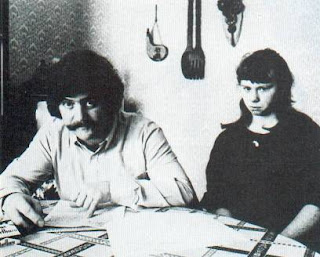 |
| Grégory Villemin |
Shortly after 5pm on the evening of Tuesday October 16th 1984, four year old Grégory Villemin was taken from outside his house in the village of Lépanges-Sur-Vologne in the Vosges region of France. At 9.15pm that day his body, bound at the wrists and ankles, was recovered from the River Vologne in the nearby village of Docelles. The official cause of death was drowning, but the small amount of water in his lungs and the later discovery of a syringe and an ampule of Insulin suggested that he was also drugged before entering the water.
Initial suspicion focused on Bernard Laroche, a cousin of Grégory's father Jean-Marie. Handwriting experts called in by the police identified him as a potential author of numerous threatening letters to Grégory's parents, a theory supported by claims of rival 'clans' within the extended family. He was interviewed and provided an alibi for the time of the kidnap and murder, but police found it unconvincing.
 |
| Bernard Laroche; Murielle Bolle |
Laroche's alibi relied heavily on corroboration by his 15 year old sister-in-law, with whom he and his wife shared their home. But when interviewed, after initially supporting his version of events she changed her account when challenged, stating instead that he had picked her up from school that day before driving to a nearby village where he had collected a young boy. They then drove to another village, where Laroche took the boy from the car, disappearing from sight briefly before returning alone. Murielle stated that at the time of the events she recognised neither the boy nor the villages, but later realised from press articles that it was Grégory Villemin and that the villages were Lépanges-Sur-Vologne and Docelles, respectively.
After repeating this version of events to the instructing magistrate Jean-Michel Lambert, Bernard Laroche was arrested and Murielle sent home. But then Lambert made a mistake which was to blight the case from that day to this. Asked by waiting press what had led to the arrest of Laroche, Lambert stated that it was the result of a “temoignage capitale” – a statement from a key witness. Was it Murielle Bolle? Yes. Was she in the car with him? Er… yes. In a matter of a few seconds he publicly identified the primary witness against Bernard Laroche - a witness he had just sent back to Laroche's family with no protection.
 |
| Jean-Michel Lambert: 'Le Juge Lambert' |
What happened in the Laroche house after Murielle returned there on the evening of Monday 5th November 1984 is a matter of debate to this day, but the next day she retracted her statement in its entirety, claiming later that she had been threatened by police and telling TV reporters and press “Bernard is innocent; my brother-in-law is innocent”. Lambert tried to maintain the case against Laroche, but procedural errors meant that the earlier handwriting analysis could not be used in evidence. As a result the case faltered and, after three months on remand, Bernard Laroche was released in the February of 1985.
Following his release, the case was taken out of the hands of the Gendarmerie and passed to the civilian police, who began a new inquiry. New handwriting experts were commissioned and suspicion moved from Laroche towards Christine Villemin, Grégory's mother; a fact that she and her husband first learned via an RTL radio broadcast in March 1985. Stunned by the news, the newly pregnant Christine suffered a haemorrhage and was rushed to hospital. Leaving his wife in the hands of medical staff, Jean-Marie returned home, picked up a shotgun, drove to the home of Bernard Laroche and shot him dead, as he had previously threatened to do in front of journalists on the day of Laroche's release in February. He then returned to the hospital and asked nurses to call the police.
 |
| Jean-Marie and Christine Villemin |
Christine Villemin was charged with the murder of Grégory in July 1985, but again the case faltered: handwriting analysis proved inconclusive; witness statements unreliable and doubts were raised over the way physical evidence was collected. Christine was bailed in 1985, but it was not until 1993 that she was formally cleared of all charges following a new inquiry by the Court of Appeal in Dijon.
1993 also saw the trial of Jean-Marie Villemin for the killing of Bernard Laroche. His lawyers sought to make the event a posthumous trial of Laroche, presenting his death as a justifiable homicide. Murielle Bolle maintained her retraction, however and Jean-Marie was convicted. Sentenced to 5 years, he was released ten days later on the basis of time served while on remand between 1985 and 1987.
And from there the case began to go cold. Attempts at DNA analysis in 2000 proved inconclusive. A new attempt in 2009 led to the inquiry being briefly re-opened in 2011, to little avail. It was not until May 2017 that a series of bizarre twists led to this apparently coldest of cases suddenly coming back to the boil...